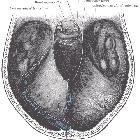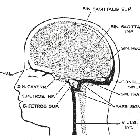Tentorium cerebelli






The tentorium cerebelli (plural: tentoria cerebellorum) is the second largest dural fold after the falx cerebri. It lies in the axial plane attached perpendicularly to the falx cerebri and divides the cranial cavity into supratentorial and infratentorial compartments . It has free and attached margins .
Gross anatomy
The tentorium cerebelli is attached to the falx cerebri at its midline, and this attachment contains the straight sinus. This attachment is more superior than its anterolateral and posterolateral attachments giving it a "tented" appearance .
The anterior portion contains the tentorial notch (or tentorial incisure/incisura) which is a U-shaped (concave) free edge and extends anteriorly to attach to the anterior clinoid processes and forms the lateral part of the cavernous sinus . The deep tentorial notch surrounds the tentorial hiatus, which allows communication between the supratentorial and infratentorial compartments.
The anterolateral margin attaches to the superior border of the petrous part of the temporal bone. This margin lies inferior to the tentorial notch and extends anteriorly to attach to the posterior clinoid process and contains the superior petrosal sinus .
The posterolateral margin separates into the two layers of dura and attaches to the edges of the transverse sulci of the occipital bone. As it extends anteriorly it attaches to the posteroinferior angles of the parietal bone . At its most posterior aspect, it is attached to the internal occipital protuberance and posterolaterally contains the transverse sinus .
For blood supply and innervation, see dura.
Relations
- superiorly: occipital lobe
- inferiorly: cerebellum
- anteriorly: midbrain, cerebral aqueduct
- medially: extends over the anterior surface of the petrous part of the temporal bone forming Meckel cave
Radiographic features
CT
- non-contrast
- appreciated best on coronal and sagittal views as a linear structure separating the occipital lobe from the cerebellum (or supratentorial compartment from the infratentorial compartment)
- on coronal views is visible as being continuous with the falx cerebri
- contrast-enhanced
- on axial views tentorial margins best appreciated with IV contrast as uniform linear densities
Related pathology
- normal intracranial calcifications
- meningioma
- ascending transtentorial herniation
- tentorium cerebelli subdural hematoma
Siehe auch:
und weiter:

 Assoziationen und Differentialdiagnosen zu Tentorium cerebelli:
Assoziationen und Differentialdiagnosen zu Tentorium cerebelli:

